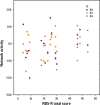Functional connectivity during cognitive control in children with autism spectrum disorder: an independent component analysis
- PMID: 24845879
- PMCID: PMC4141973
- DOI: 10.1007/s00702-014-1237-8
Functional connectivity during cognitive control in children with autism spectrum disorder: an independent component analysis
Abstract
Restrictive and repetitive behavior in autism may be related to deficits in cognitive control. Here, we aimed to assess functional connectivity during a cognitive control task and compare brain network activity and connectivity in children with autism spectrum disorders (ASD) and typically developing children using a multivariate data-driven approach. 19 high-functioning boys with ASD and 19 age-matched typically developing boys were included in this study. Functional magnetic resonance imaging was performed at 3T during the performance of a cognitive control task (go/no-go paradigm). Functional networks were identified using independent component analysis. Network activity and connectivity was compared between groups and correlated with clinical measures of rigid behavior using multivariate analysis of covariance. We found no differences between the groups in task performance or in network activity. Power analysis indicated that, if this were a real difference, it would require nearly 800 subjects to show group differences in network activity using this paradigm. Neither were there correlations between network activity and rigid behavior. Our data do not provide support for the presence of deficits in cognitive control in children with ASD, or the functional networks supporting this ability.
Figures




References
-
- Allen EA, Erhardt EB, Damaraju E, Gruner W, Segall JM, Silva RF, Havlicek M, Rachakonda S, Fries J, Kalyanam R, Michael AM, Caprihan A, Turner JA, Eichele T, Adelsheim S, Bryan AD, Bustillo J, Clark VP, Feldstein Ewing SW, Filbey F, Ford CC, Hutchison K, Jung RE, Kiehl KA, Kodituwakku P, Komesu YM, Mayer AR, Pearlson GD, Phillips JP, Sadek JR, Stevens M, Teuscher U, Thoma RJ, Calhoun VD. A baseline for the multivariate comparison of resting-state networks. Front Syst Neurosci. 2011;4(5):2. - PMC - PubMed
-
- American Psychiatric Association (ed) (2000) Diagnostic and statistical manual of mental disorders: DSM-IV-TR®. American Psychiatric Pub
-
- Balsters JH, O’Connell RG, Galli A, Nolan H, Greco E, Kilcullen SM, Bokde AL, Lai R, Upton N, Robertson IH. Changes in resting connectivity with age: a simultaneous electroencephalogram and functional magnetic resonance imaging investigation. Neurobiol Aging. 2013;34(9):2194–2207. doi: 10.1016/j.neurobiolaging.2013.03.004. - DOI - PubMed
Publication types
MeSH terms
LinkOut - more resources
Full Text Sources
Other Literature Sources

